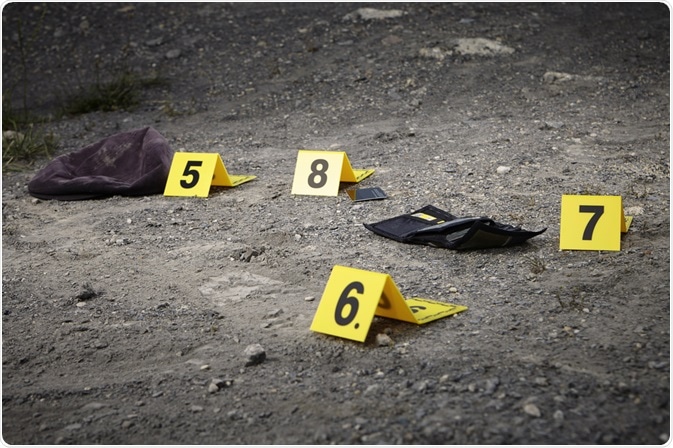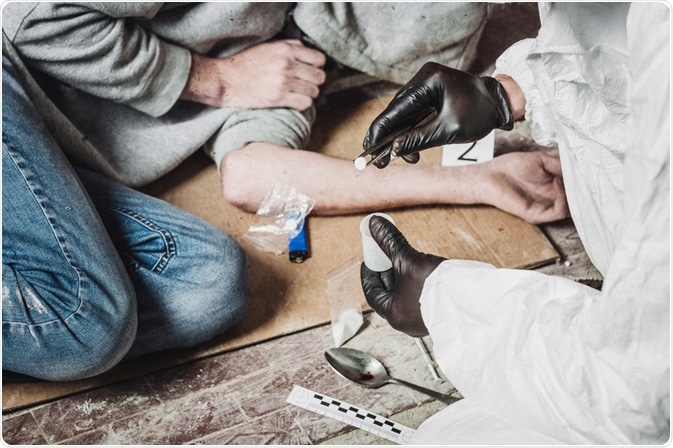The samples found at a crime scene can exist in trace amounts, and the analysis should be done with extreme care, or the sample might be lost to the surroundings and no conclusion of the scientific evidence for the investigation can be made for court testimony.

Image Credit: Couperfield/Shutterstock.com
An optimum analytical technique that does not destroy the small amounts of evidence is spectroscopy. The evidence, ranging from biological fluids, drugs to trace materials found at the crime scene can be examined as they are preserved with this technique. Furthermore, no sample preparation is needed for this particular technique, hence making it time-efficient compared to other analytical techniques.
Spectroscopy for Smokeless Powders Identification
Smokeless powders propellants deposited from a cartridge become useful forensic evidence when no weapon is found on a shooting case. The identification of this type of physical evidence can aid crime investigators to assess what crime was committed, as well as linking a suspect to the crime scene by conducting a comparison analysis.
The information of smokeless powders recovered from the crime scene can be compared to a database to identify what type of smokeless powder was being used to aid the shooting crime. Instrumental analysis using FTIR and GC-MS techniques are commonly used in forensic laboratories to provide chemical characteristics information regarding the compounds recovered.
FTIR is used to determine the presence of the energetic ingredient, nitrocellulose, through identifying the functional groups that exist in the smokeless powders recovered. While GC-MS can identify other organic chemical components based on their mass chromatograms.
Aging bruises using spectroscopy
Spectroscopy for the analysis of fibers
Fibers can indicate contacts of a suspect with the crime scene and/or the victim through techniques to determine whether two textile fibers are similar. Spectroscopy techniques are highly advantageous for fiber analysis as they are non-destructive on the sample, no sample preparation is needed, and on-site examinations are also available.
UV-Vis MSP is often used in forensic laboratories for its high discriminatory power on textile fibers, compared to the selectivity of Raman spectroscopy as another discriminatory technique. UV-Vis MSP can classify artificial leather fibers and the technique is commonly used as a routine study for fibers.
Nevertheless, the Raman spectroscopy can serve as a complementary analysis to UV-Vis MSP. While FTIR spectroscopy can be used to examine fibers based on their measurement conditions, fiber type, and their overall structure. IR spectroscopy identifies the difference in acrylic fibers based on their excitation wavelengths, which makes the analytical technique efficient for studying the matrix of textile fibers.

Image Credit: Sendo Serra/Shutterstock.com
Spectroscopy to analyze automotive paints
Paint bits are useful forensic evidence as they are usually encountered during vandalism, car accidents, and burglaries. The trace materials are compared to draw association of a crime scene to a potential suspect.
Zieba-Palus et al. has successfully solved multiple hit-and-run cases using Raman spectroscopy. Raman spectroscopy is an efficient analytical technique for its quick and precise analysis, as well as its ability to examine trace level samples to the tens of micrometers.
Furthermore, automotive coatings consisting of both organic and inorganic chemical compounds can be identified by Raman and FTIR spectroscopy techniques. Whereas the additives for these compositions on the automotive coating can be analyzed through SEM/EDX and ICP-MS techniques.
Using spectroscopy to identify lipstick traces
Spectroscopy for forensic toxicology
Raman spectroscopy serves the field of forensic toxicology as an analytical tool to detect and quantify drugs in biological specimens. This technique is efficient in providing confirmatory testing for biological matrices as the technique is not influenced by the presence of water, where the matrices have high contents of the molecule.
This analytical tool is further beneficial with its low detection level. To illustrate, D'Elia, et al. found that Raman spectroscopy can detect drugs to the lowest micrograms within 7 days of deposition.
Furthermore, the purity of the drug as well as the chain of custody, the two crucial things uphold in forensic laboratories, are preserved for the technique's non-destructive nature. However, future developments to improve fluorescence interference from the strong fluorescence background need to be implemented to efficiently identify drug samples.

Image Credit: PRESSLAB/Shutterstock.com
Spectroscopy to compare glass as forensic evidence
Glass pieces exist as trace materials encountered during criminal cases of burglary, traffic accidents, and theft. The examination of this physical evidence usually involves elemental analysis, after two glass materials are found similar based on physical examination. Analytical techniques such as SEM-EDX, FTIR, XRF, and ICP-OES and ICP-MS are utilized in forensic laboratories to obtain information on the elements involved within these glass materials.
Fluorescence spectroscopy may also be used for visual comparisons as most glass pieces fluoresce. Nonetheless, the glass surface that fluoresces must be preserved for the fluorescence to be properly detected.
FTIR, transmission electron microscopy, and XRF can also be used to analyze the components in the glass coatings, where these characteristics can be used to compare two glass samples.
References
- FBI. (2020). The Manufacture Of Smokeless Powders And Their Forensic Analysis By Robert M. Heramb And Bruce R. Mccord. [online] Available at: https://archives.fbi.gov/archives/about-us/lab/forensic-science-communications/fsc/april2002/mccord.htm [Accessed 23 August 2020].
- Ferreira, K., Oliveira, A. and Gomes, J. (2017). Raman spectroscopy of automotive paints: Forensic analysis of variability and spectral quality. Spectroscopy Letters, [online] 50(2), pp.102-110. Available at: <https://www.tandfonline.com/doi/pdf/10.1080/00387010.2017.1288635?casa_token=Ufe8hpEwJIcAAAAA:rVhmEyO1wub8_0y1BJjOGaLS_WKaxJnFDegSexUVoLDXX-ywi2bq8lS4bN4V93d2xYqm7_Xi6XiYlg>.
- Khandasammy, S., Fikiet, M., Mistek, E., Ahmed, Y., Halámková, L., Bueno, J., and Lednev, I. (2018). Bloodstains, paintings, and drugs: Raman spectroscopy applications in forensic science. Forensic Chemistry, [online] 8, pp.111-133. Available at: <http://Bloodstains, Paintings, and Drugs: Raman Spectroscopy Applications in Forensic Science>.
- Meleiro, P. and García-Ruiz, C. (2015). Spectroscopic techniques for the forensic analysis of textile fibers. Applied Spectroscopy Reviews, [online] 51(4), pp.278-301. Available at: <https://www.researchgate.net/publication/291950705_Spectroscopic_techniques_for_the_forensic_analysis_of_textile_fibers>.
- Sigman, M., Williams, M., Dennis, D. K. (2017). Smokeless Powder Reference Collection and SWGFEX Smokeless Powders Database Expansion. National Criminal Justice Reference Service, [online]. Available at: <https://www.ncjrs.gov/pdffiles1/nij/grants/250933.pdf>.
Further Reading